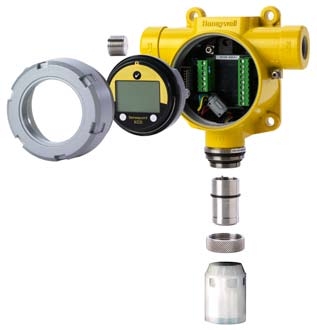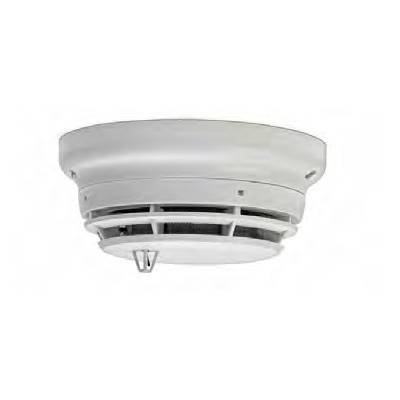Features
TrueAlarm photoelectric smoke sensing and heat
sensing combined in one housing to provide:
- Smoke activity accurately monitored by TrueAlarm photoelectric sensing technology
- Thermal activity accurately monitored by TrueAlarm thermistor sensing technology
- And TrueSense detection, a correlation of smoke activity and thermal activity providing intelligent fire detection earlier than with either activity alone
For use with Simplex ® 4007ES, 4010ES, 4100ES,
and 4100U fire alarm control panels:
- TrueAlarm analog sensor information is digitally communicated to the control panel via IDNet two-wire communications
- Special point types allow the 4098-9754 multi-sensor to communicate smoke and heat analog sensing data using only one IDNet address
- Individual sensor information is processed by the host control panel to determine sensor status and to determine whether conditions are normal, off-normal, or alarm
- (4100U fire alarm control panels require software revision 11 or higher with multi-point compatible IDNet transmission modules)
Alarms can be determined by either:
- Smoke detection with selectable sensitivity from 0.2 to 3.7 %/ft obscuration (refer to additional information on page 2)
- Heat detection selectable as fixed temperature or fixed with selectable rate-of-rise
- TrueSense intelligent analysis of the combination of smoke and heat activity
Additional design features:
- Functional and architecturally styled enclosures for ceiling or wall mounting
- Smoke sensor louver design that directs air flow to chamber enhancing smoke capture
- Built-in magnetic test feature
- Compatible with standard bases (including relay control), sounder bases, and isolator bases
- Designed for EMI compatibility
TrueAlarm Multi-Sensor Description
TrueAlarm multi-sensor model 4098-9754 combine the
established performances of a TrueAlarm photoelectric
smoke sensor with a fast-acting and accurate TrueAlarm
thermal sensor to provide both features in a single
sensor/base assembly.
Digital Communication of Analog Sensing.
Analog information from each sensor is digitally
communicated to the control panel where it is analyzed.
Photoelectric sensor input is stored and tracked as an
average value with an alarm or abnormal condition being
determined by comparing the sensor’s present value
against its average value. Thermal data is processed to
look for absolute or rate-of-rise temperature as desired.
Intelligent Data Evaluation.
Monitoring each
photoelectric sensor’s average value provides a software
filtering process that compensates for environmental
factors (dust, dirt, etc.) and component aging, providing
an accurate reference for evaluating new activity. The
result is a significant reduction in the probability of false
or nuisance alarms caused by shifts in sensitivity, either
up or down. Status indications of dirty and excessively
dirty are automatically generated allowing maintenance to
be performed per device.
Control Panel Selection.
Peak activity per sensor is
stored to assist in evaluating specific locations. The alarm
set point for each TrueAlarm sensor is determined at the
control panel, selectable as more or less sensitive as the
individual application requires.
Multi-Point Reporting and CO Base Reference.
Reporting 4098-9754 “sub-points” under its single
address varies with the base used. Muti-point details are
listed in data sheet S4090-0011.
Using the 4098-9754 with CO sensor bases is detailed in
data sheet S4098-0052.
Timed/Multi-Stage Selection.
Alarm set points can be
programmed for timed automatic sensitivity selection
(such as more sensitive at night, less sensitive during
day). Control panel programming can also provide
multi-stage operation per sensor. For example, a 0.2%
level may cause a warning to prompt investigation while a
2.5% level may initiate an alarm.
Sensor Alarm and Trouble LED Indication.
Each sensor base’s LED pulses to indicate communications
with the panel. If the control panel determines that a
sensor is in alarm, or that it is dirty or has some other type
of trouble, the details are annunciated at the control panel
and that sensor base’s LED will be turned on steadily.
During a system alarm, the control panel will control the
LEDs such that an LED indicating a trouble will return to
pulsing to help identify the alarmed sensors.
TrueAlarm Analog Sensor Features
General mechanical:
- Housing is sealed against rear air flow entry
- Electronics are EMI/RFI shielded
Smoke sensing:
- Photoelectric light scattering sensing technology
- 360° smoke entry for optimum response
- Chamber screen provides protection from dirt, dust, and insects
Heat sensing:
- Fast response thermistor design
- Rate compensated, self-resetting operation
- Control panel can select per sensor for fixed temperature sensing, rate-of-rise temperature sensing, or the combination of both
Photoelectric Sensing Details
TrueAlarm photoelectric sensors use a stable,
pulsed infrared LED light source and a silicon photodiode
receiver to provide consistent and accurate low power
smoke sensing. Seven levels of sensitivity are available
for each individual sensor, ranging from 0.2% to 3.7% per
foot of smoke obscuration. Sensitivities of 0.2%, 0.5%,
and 1% are for special applications in clean areas.
Standard sensitivities are 1.5%, 2.0%, 2.5%, 3.0%, and
3.7%. Application type and sensitivity are selected and
then monitored at the fire alarm control panel.*
Sensor head design provides 360° smoke entry for
optimum smoke response. Because of the photoelectric
sensing technology, the 4098-9754 sensor is UL listed for
air velocity of up to 4000 ft/min. However, care must be
taken in determining sensor locations to avoid areas
where local airflow may also impact any smoke flow.
(Refer to the application reference section on this page.)
Heat Sensing Details
TrueAlarm heat sensors monitor a fast reacting
thermistor providing operation that is self-restoring and
rate compensated. Due to its small thermal mass, the
sensor accurately and quickly measures the local
temperature for analysis at the fire alarm control panel.
The control panel allows alarm selection to be per sensor
as fixed temperature, or rate-of-rise temperature, or the
combination of both.
Temperature Detection. Rate-of-rise temperature
detection is selectable at the control panel for either 15° F
(8.3° C) or 20° F (11.1° C) per minute. Fixed temperature
sensing is independent of rate-of-rise sensing and
selectable to operate at 135° F (57.2° C) or 155° F
(68° C). In a slow developing fire, the temperature may
not increase rapidly enough to operate the rate-of-rise
feature. However, an alarm will be initiated when the
temperature reaches its selected fixed temperature setting.
Utility Temperature Monitoring. TrueAlarm heat
sensors can be programmed as a utility device to monitor
for temperature extremes in the range from 32° F to
122° F (0° C to 50° C). This feature can provide freeze
warnings or alert to HVAC system problems.
TrueSense Detection Details
Control Panel Sensor Analysis. Each multi-sensor’s
smoke and heat sensing element provides data for
evaluation at the fire alarm control panel where four
independent detection modes are evaluated. They are:
- Fixed temperature heat detection
- Rate-of-rise heat detection
- TrueAlarm photoelectric smoke detection
- And TrueSense correlation detection
Comparing Photoelectric Activity and Thermal
Activity. TrueSense analysis correlates both thermal
activity and smoke activity at a single multi-sensor
location using an extensively tested covariance
relationship. As a result, TrueSense detection improves
response to conditions indicative of faster acting, hot
flaming fires when compared to the response of either
photoelectric smoke activity or thermal activity alone.
High Integrity Detection. TrueSense operation
provides early fire detection and maintains the established
high level of immunity to false alarms and nuisance
alarms that is inherent with TrueAlarm sensor operation.
Application Reference
Sensor locations should be determined after careful
consideration of the physical layout and contents of the
area to be protected. Refer to NFPA 72, the National Fire
Alarm and Signaling Code. On smooth ceilings, smoke
sensor spacing of 30 ft (9.1 m) may be used as a guide.*
Multi-Sensor Base Features
Base mounted address selection allows the address
of the multi-sensor base to remain with its programmed
location when the sensor is removed for service.
Integral red LED indicates power-on by pulsing, or
alarm or trouble when steady on, reflecting status of either
sensor. The exact status of the specific sensing element is
annunciated at the fire alarm control panel.
Fire Alarm Control Panel Features
- Individual smoke sensitivity and temperature operation is selectable for each sensor
- Sensitivity monitoring that satisfies NFPA 72 sensitivity testing requirements
- Peak value logging allows accurate analysis for sensitivity selection
- Automatic, once per minute individual sensor calibration check verifies sensor integrity
- Multi-stage alarm operation
- Selectable alarm verification
- Automatic environmental compensation and determination of dirty and excessively dirty
- TrueSense analysis of smoke and heat activity
- Ability to display and print detailed sensor information in plain English language
- Smoke sensitivity displayed in percent per foot and temperature readings selectable as Fahrenheit or Celsius

